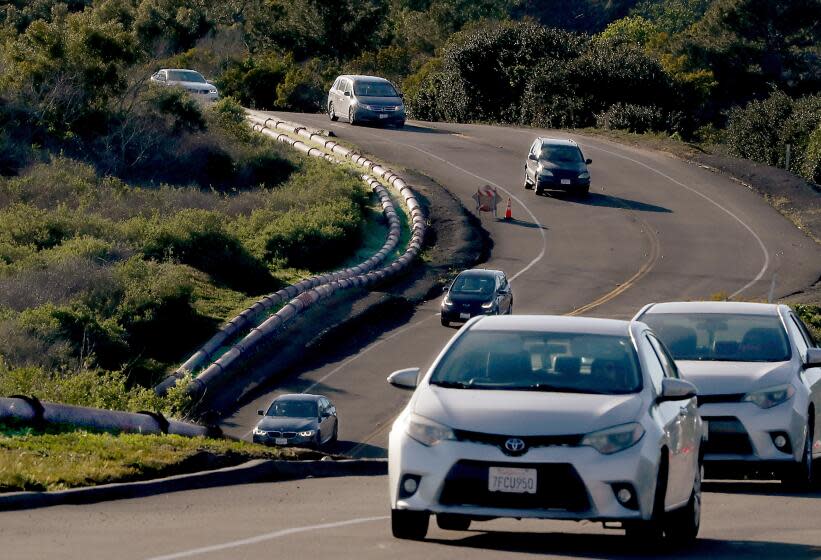Rancho Palos Verdes bans bikes, motorcycles from road as landslide causes it to shift and crack

Effortlessly whizzing down a hill along a Rancho Palos Verdes bike path earlier this month felt freeing — especially after pedaling for several miles — until I saw a break in the asphalt below.
Panicked, I pumped my brakes and passed over the scarred roadway — ungracefully but thankfully without injury.
Now, thanks to hazards like those, the city is temporarily closing a stretch of Palos Verdes Drive South to two-wheeled vehicles, citing the land movement that continues to plague the Palos Verdes Peninsula.
The Rancho Palos Verdes City Council voted Tuesday to ban bikes, motorcycles and scooters on roughly two miles of the roadway for at least six months.
Like me, many bicyclists are fans of the route. Some of them voiced their displeasure at the meeting.
Todd Bernhardt, a Rancho Palos Verdes resident and an officer on the board of a South Bay cycling club, suggested the city could keep the area open to two-wheelers if it implemented other safeguards.
“[A]s long as the city takes other measures, such as limiting the speed of all vehicles, increasing the amount of signage, instituting additional traffic control measures for all vehicles and educating the community about the hazards on this stretch of road," Bernhardt said, "then I know from firsthand experience that it can be ridden safely and will pose no risk to cyclists or the city of Rancho Palos Verdes."
Bicyclist Geoffrey Loui said bikes could maneuver through the area as well as or better than cars, some of which he'd seen skidding and going sideways.
Loui said he saw a truck "clearing through the air for a car length and a half before actually coming back in contact with the pavement. It’s full ‘Streets of San Francisco’ style.”
The city has for years patched up Palos Verdes Drive South as it has shifted due to the peninsula's landslide complex. A portion of the roadway has a drop so severe that locals refer to it as "the ski jump."
The council's decision arrives about a month after it was announced that the historic Wayfarers Chapel would be dismantled to protect it from accelerating land movement.
Earlier this year, the chapel and homes in the area sustained damage from the slow-moving landslide complex, which escalated after two consecutive fierce winters that brought heavy rains.
Read more: Winter rains fuel 'unprecedented' acceleration, expansion of landslides in Rancho Palos Verdes
The newly implemented vehicle ban runs from the Lloyd Wright-designed chapel to Schooner Drive in a bid to “prevent injuries due to the poor condition of the roadway,” city officials said in a news release.
According to the city, the land is moving at a rate of 7 to 12 inches per week.
In six months, the council will revisit the ban on bikes and motorcycles and make a call on whether to lift or extend it.
Wayfarers Chapel closed its doors in February because of safety concerns.
The hope is that the Instagram-famous national historic landmark, spiritual sanctuary and beloved wedding venue can be rebuilt on more stable ground.
Land movement isn’t a new phenomenon on the Palos Verdes Peninsula. But earlier this year, the shifting not only accelerated but damaged additional areas.
“What’s happening is unprecedented,” Mike Phipps, Rancho Palos Verdes’ contracted geologist, told The Times in February. “We haven’t seen this kind of movement in the upper areas of the landslide in the whole history of monitoring this landslide.”
This story originally appeared in Los Angeles Times.


